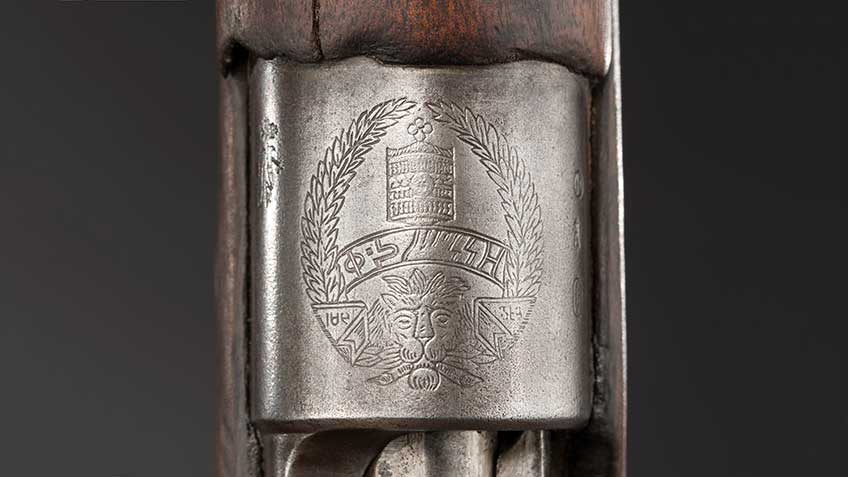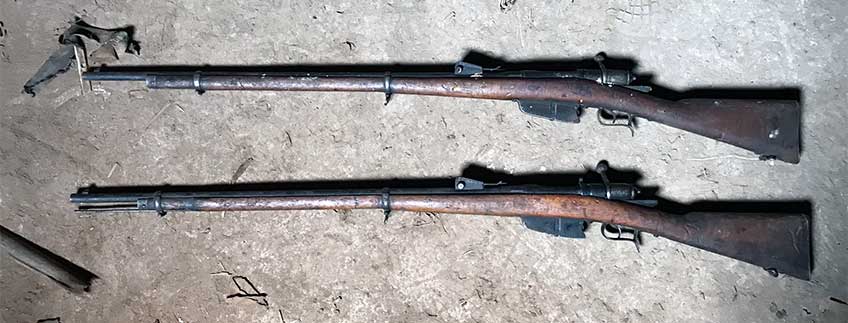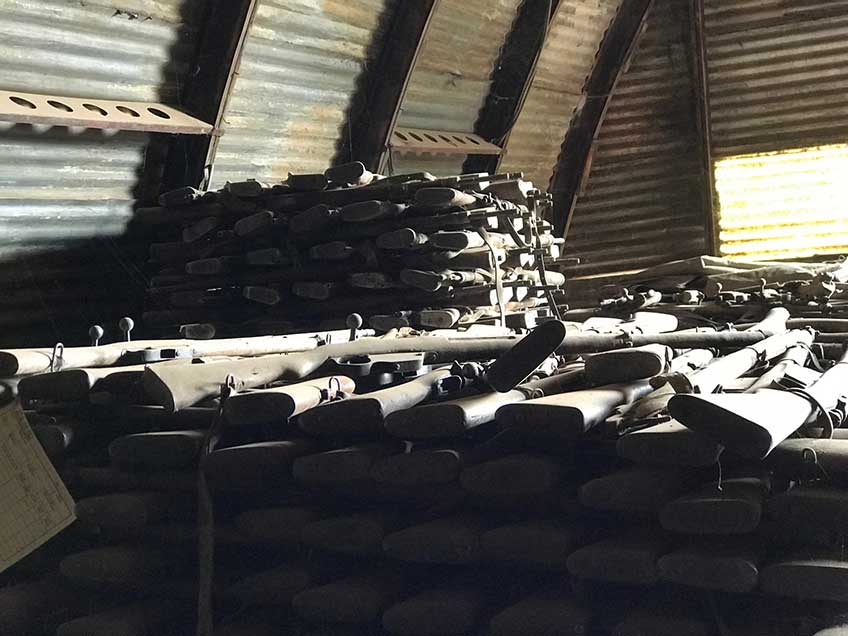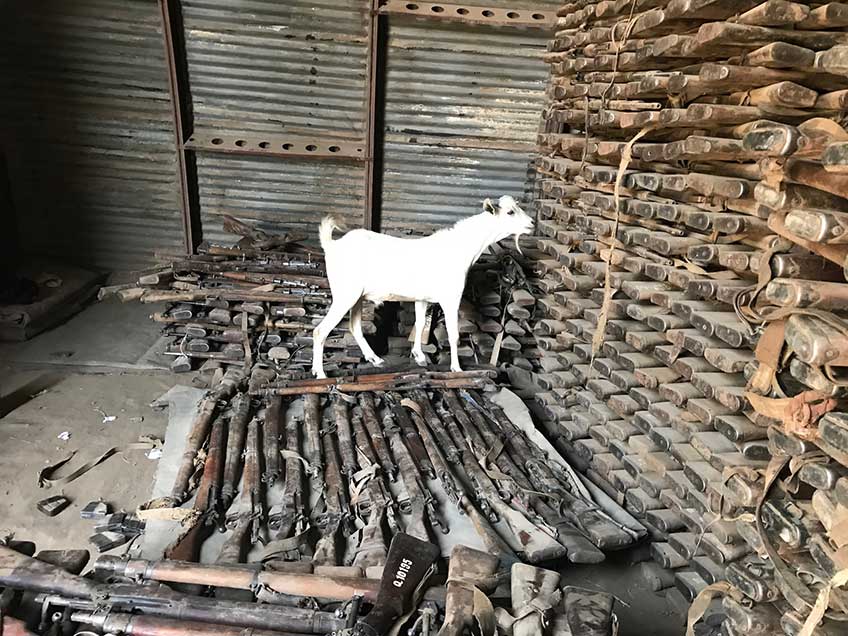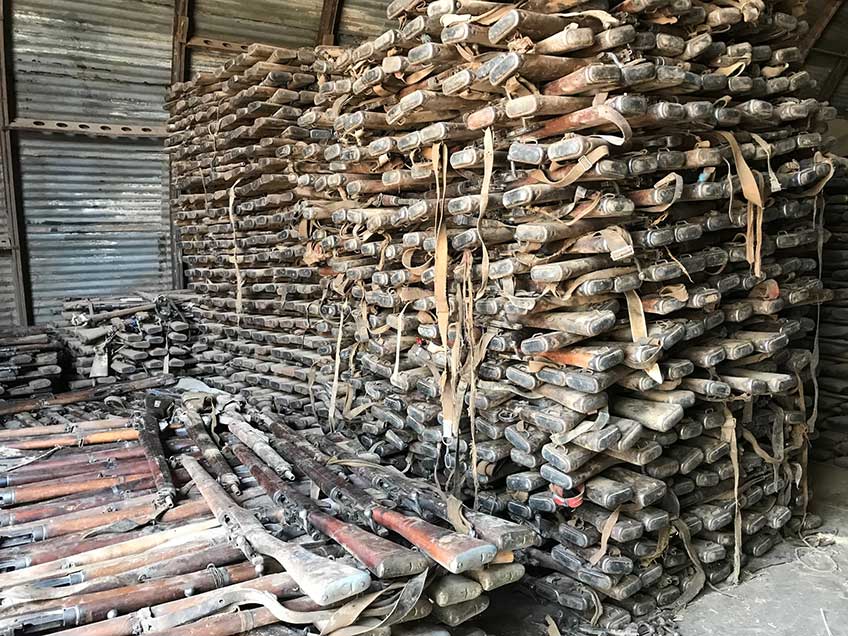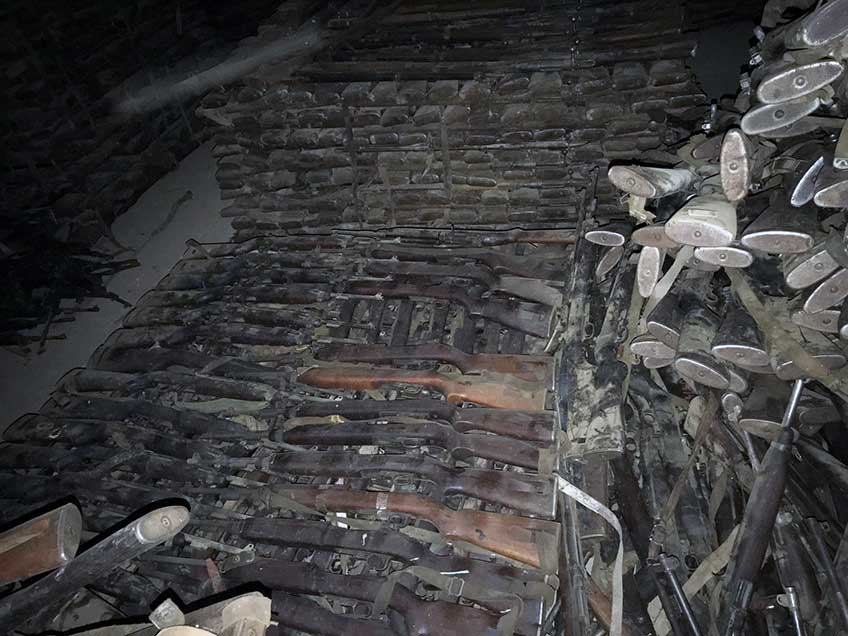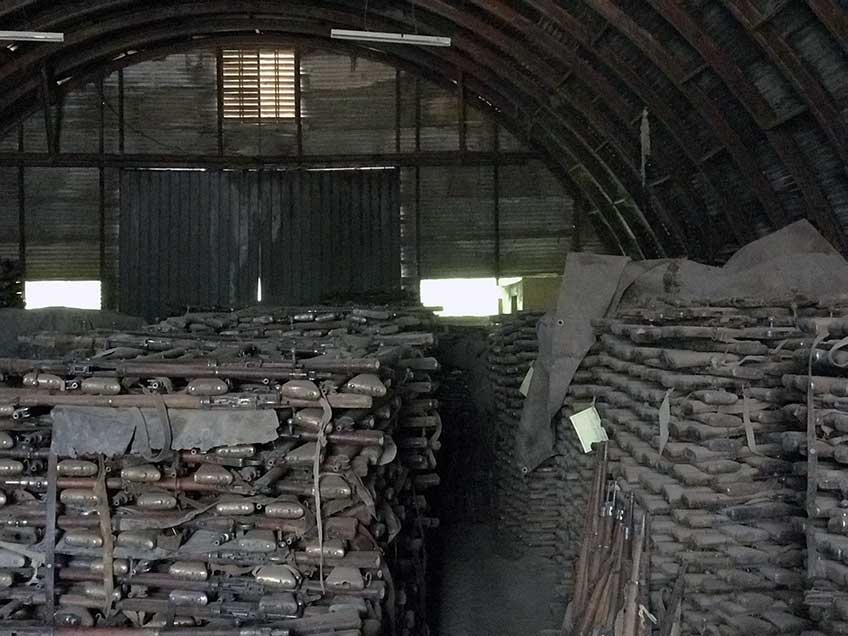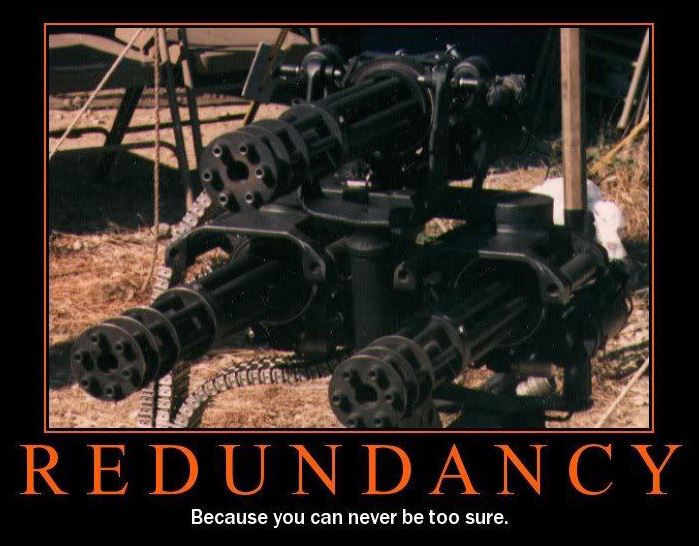Today, we know it as Ethiopia. Before that, it was the Abyssinian Empire, and it was headed by Emperor Haile Selassie I from 1930 until he was deposed by a Communist military dictatorship in 1974. The guns being brought into the United States by
Royal Tiger Imports represent arms acquired by Ethiopia before he came to power, while he reigned, as well as after. They weren’t all Selassie’s, but most were carried while he ruled the East African nation.
After the Communists took over, firearms handed in by the people (including at least one Winchester 1895 in .405 Win.) and obsolete military arms all went into storage. Thankfully, it’s pretty dry there. That’s where they remained until Uli Wiegand of InterOrdnance and Royal Tiger Imports bought the lot, ranging from muzzleloaders to M1 carbines to guns furnished by Communist nations in the 1970s.
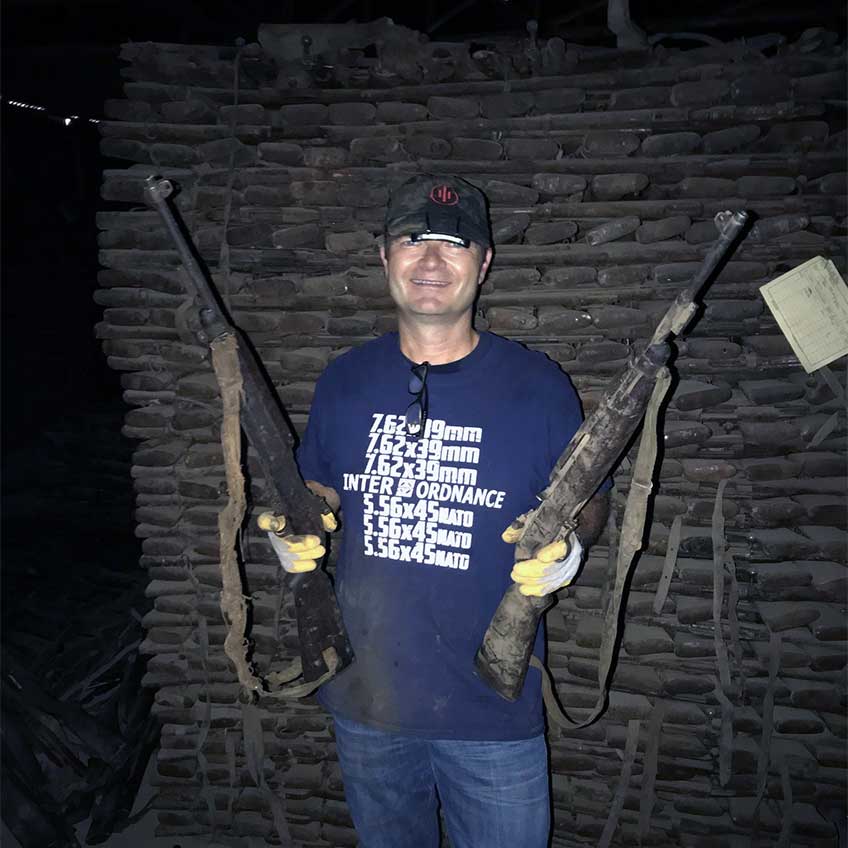
Uli Weigand pictured with some of the M1 carbines discovered in the cache.
There are early bolt-actions, as well as Fabrique Nationale Mausers with the Abyssinian crest. Guns left by the Italians, who occupied Ethiopia from 1935 to 1941, include just about every model of Carcano. Mausers bought before or given to Ethiopia after World War II are joined by lots of Lee-Enfields. Did I mention there are a lot of Lee-Enfields?
These guns, in both variety and quantity, are unlike anything we’ve seen in surplus imports for decades—with the International Military Antiques acquisition of the contents of the armory in Nepal being the closest thing in recent memory.
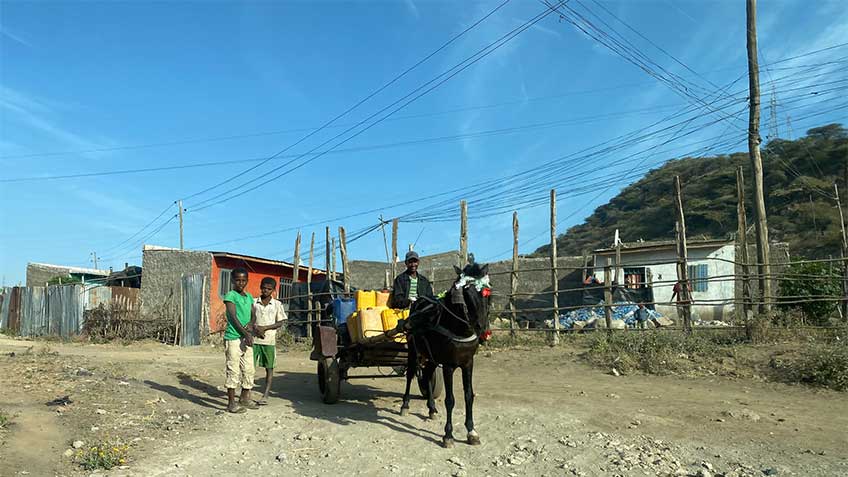
The quiet, rural surroundings gave no hints of the thousands of guns hidden in warehouses nearby.
This deal was more than eight years in the making, Wiegand told me. It’s been known that these guns existed, but exactly how many there were, what they were and what kind of shape they were in wasn’t generally known. As each new lot is imported by Royal Tiger, we learn more.
A Troubled Land
The guns reflect the troubled times experienced by the East African nation, and they reflect more than a century of conflict, mostly started by the Italians in Abyssinia. During the heyday of colonialism, Abyssinia managed to remain independent, not for lack of the Italians trying, though.
It began in 1887 and went through 1889, depending on what historiography you follow—as perhaps the first Italo-Abyssinian War, even though a later war goes officially by that name. We know there was a war involving Italians and Ethiopians, but when exactly it ended is a matter of speculation.
This resulted in at least one resounding defeat for the Italians and their allies, the creation of Italian Eritrea and bitter feelings that led to what is properly known as the first Italo-Abyssinian war in 1887. It was ended by the treaty of Wachale in 1889.
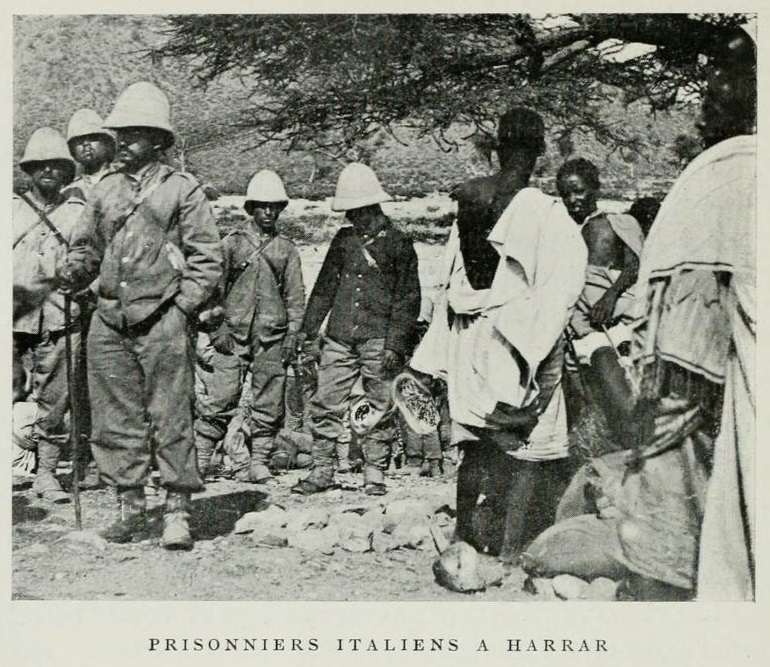
Italian prisoners of war at Harrar, capital of the Ethiopian province of the same same. The soldiers, made prisoners during the First Italo-Ethiopian War, are awaiting repatriation to Italy. The picture was taken in March 1897 by the second in command of a French mission to Ethiopia, during a stopover in Harrar.
The Abyssinians thought they were still independent; the Italians thought Abyssinia was now a colony of theirs. It came to a fighting another war in 1895-1896, where the Italians suffered a major defeat at the Battle of Adwa, a defeat that stung their national pride—pride that would be resurgent in the 1930s.
The defeat of the Italians at the hands of Abyssinian forces kept the Italians in Eritrea and Italian Somaliland out until 1935. That was the start of the two-year conflict called the Second Italo-Abyssinian war.
Arming Against The Invader
In 1916 or 1917, Haile Selassie became regent of the Abyssinian empire, and he set about modernizing its armed forces—something he would seriously attempt after he became Emperor of Ethiopia in 1930. Ever shop for an armored car squadron? Selassie did.
While they sat out the Great War, the Abyssinians paid close attention. In 1924, Selassie went to Europe, and one of the places he toured was Fabrique Nationale in Herstal, Belgium.
According to my friend and author Anthony Vanderlinden in FN Mauser rifles, an excellent book on the bolt-actions made by Fabrique Nationale (anything by Anthony is excellent, by the way), he notes that as early as 1922, Selassie was acquiring arms and ammunition, at first from the French.
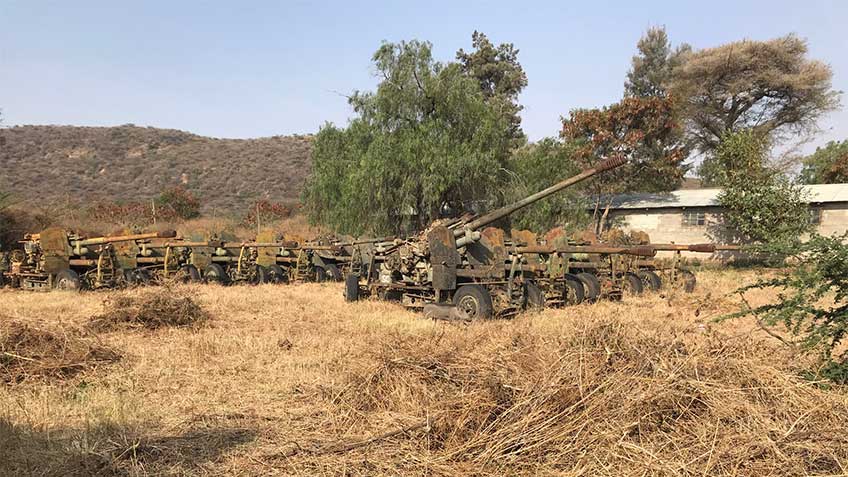
Alongside the warehouses holding small arms, Weigand and the Royal Tiger Imports team found artillery pieces rotting in the field.
With a resumption of old-school colonialism, Selassie knew his forces needed modern armament, but he settled for obsolete French designs, such as the Chassepot and the Fusile Modele 74, better known as the Gras, in 11×59 mm R. By 1932, Abyssinia had purchased, again according to Vanderlinden, 10,000 rifles from Mauser, 100 machine guns, anti-aircraft guns and more obsolete French rifles.

An M1874 Gras rifle found in the Ethiopian cache.
But it wasn’t just to France that Abyssinia would turn for arms. A Belgian military delegation, tasked with training Abyssinian forces, recommended that FN arms be purchased, in particular FN Mauser rifles and carbines, as well as FN Model 30 light machine guns, which were switch-barrel versions of the Browning Automatic Rifle, fitted with pistol grips and chambered in 8×57 mm, which was the nation’s standard cartridge.
Both rifles and carbines were procured from FN, and they bear the Abyssinian crest—showing the Lion of Judah—roll-stamped on their receiver rings left in the white. Both full-length rifles with straight bolt handles and carbines, the latter of which had turned-down bolts and a very distinctive front barrel bands, were bought from FN.
According to Vanderlinden, some 17,500 rifles, 7,500 carbines and 600 Model 30 machine guns were shipped between 1933 in 1936. Interestingly there also appears to be a quantity of very early FN Model 1889s—they were still there last year.
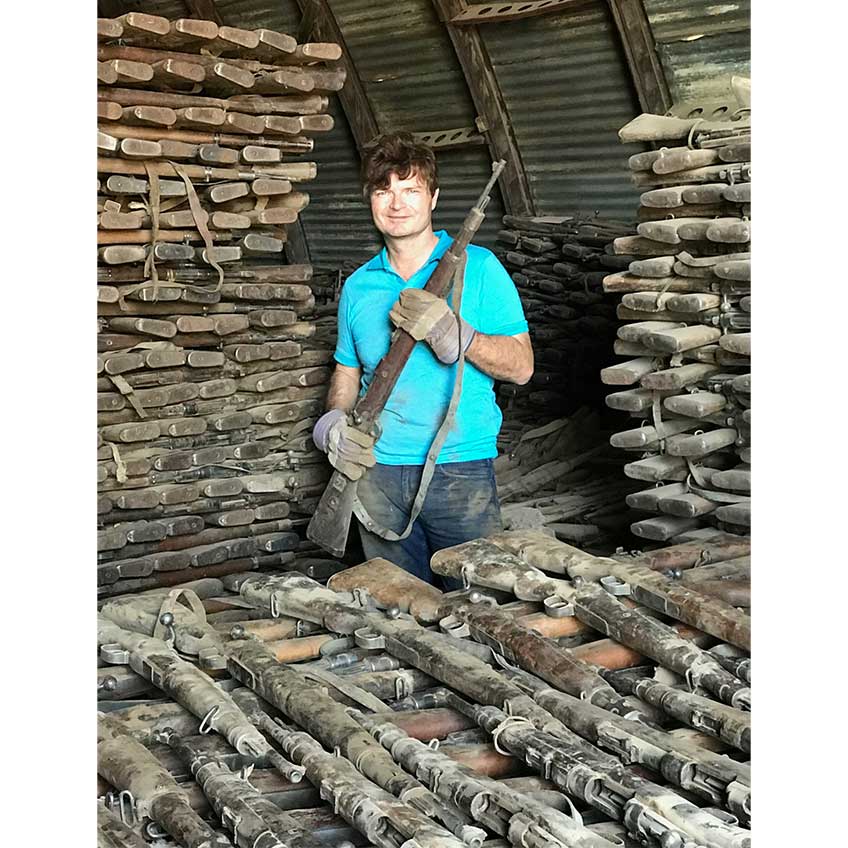
Weigand pictured with some of the Mauser rifles found in the cache.
In addition to the guns from FN, Abyssinia purchased an additional 25,000 German-made Mausers during the same period. And it was just as well, too. The Italians invaded on Oct. 3, 1935.
Another Italian Invasion…And Occupation
The Italians brought an army of 400,000 men, tanks, aircraft, artillery, machine guns and some of the most modern small arms in the world at the time. But the Abyssinians, whose rearmament was incomplete—with some still armed with spears—used topography to ambush and, at times, push back the Italian forces.
The Italians, looking for a way to unite their people around Benito Mussolini’s fascist state, needed a win. It came through ruthless means, which included the use of chemical weapons against the Abyssinians, who had no protection from things like mustard gas.
By 1936, it was over for the Abyssinians, and Selassie was forced to flee the country for England.
The British Turn The Tide
Selassie returned in 1941 as British forces kicked the Italians out of East Africa, with the help of the Ethiopians. Now allied with the British, there was an infusion of guns chambered in .303 British, a phenomenon that would continue well into the post-war period. When the Italians left—this time for good—they left a lot of rifles.
The Italian influence among the Royal Tiger guns is well represented, beginning with Vetterlis, but also including long, original Model 1891 and 1938 Carcanos. There are even some 1891/24 Carcano carbines.
Wiegand told me that this is the largest quantity of Italian Carcanos he has seen, dating back to the first guns all through guns used in the 1930s and World War II without modification. How they got there, I don’t know, but there have even been Mannlicher Model 1890 straight-pulls found in the Ethiopian warehouses.
The British, who had the nearby colony of Kenya for example, used arms to exert influence—evidence of that was in the warehouses. The Lee-Enfield family of rifles, including World War I vintage Short, Magazine Lee-Enfield (No. 1s) chambered in .303 British, of course, were there as were a surprising quantity of No. 4 Mk I Lee-Enfields manufactured during World War II—I’ve observed both Savage and BSA Shirley-made guns.
Even the United States or one of our European allies tried to create influence and favor with Ethiopians, and this is represented by M1 carbines. Perhaps of most interest to U.S. martial arms collectors, these are pretty much all original M1 carbines, delivered to the country in 1945.
From what I’ve been able to see, these guns have not been through the U.S. overhaul system, and despite being somewhat dirty, remain remarkably original—in both early and late World War II configurations.
According to the Royal Tiger Imports website, guns from Winchester, Inland Division of General Motors, Underwood, Quality Hardware, Rock-Ola, Saginaw Steering Gear Division of General Motors, National Postal Meter and IBM have all been identified.
Mausers, Mausers Everywhere
Did I mention that now is the best time in decades to be a Mauser collector? At what point the vast number of Mauser models—beyond those obtained in the 1930s—arrived in the warehouses bears additional research.
Original German 98ks are there, as are guns from the Czechs and what appear to be post-war rebuilds. Were they purchases at the end of the war from the glut of rifles or supplied by the Eastern Bloc to gain influence or prop up what became a client state?
How did so many different Mausers end up in the East African nation? Again, foreign assistance from the Communists is one explanation for the formerly German 98ks, but that doesn’t necessarily explain the German Model 1888 Commission rifles.
Selassie’s End & The Rise Of The Communists
In 1974, Selassie was deposed by a military dictatorship backed by the Soviet Union. Within a year, the Communists were in full control of Ethiopia. It is thought that in consolidating power, the Communists killed about a half million people, after first making them surrender their arms.
Some of those very arms are being imported today, because it wasn’t just military guns Weigand found in the stash. The nation was firmly in the Soviet sphere until the fall of the Berlin wall, which eventually led to the modern, multi-party Federal Democratic Republic Of Ethiopia.
Communist guns include the seldom-seen Czech VZ-52 semi-automatic rifles chambered in 7.62×45 mm—some were supplied to Castro’s Cuba as well. And there is a selection of Russian Model 91/30 Mosin-Nagants chambered in 7.62×54 mm R. There may well be more.
Treasures Abound…And More Are On The Way
From photos I’ve seen, the nondescript storage sites look fairly primitive. It’s hard to tell if some of these buildings housed rifles or perhaps livestock, but the dry, hot, arid climate of that part of the world has been kind to these rifles, for the most part. There isn’t apparent water damage or excess humidity affecting the wooden stocks.
The guns being imported are reflections of the very specific combat actions fought in East Africa, as well as the race to secure influence in the region. They date back to muzzleloaders—which we haven’t seen yet—but already being imported are French Gras rifles, in quantities that I’ve never seen before, as well Vetterlis, likely captured during the early conflicts with the Italians and their colonial troops.
Included in some of these first batches are pre-1898 guns, which are antiques and can be shipped straight from Royal Tiger to you. Other non-gun treasures have emerged as well, including some fairly rare bayonets, and there are also accessories for both the 98k and other rifles.
Some fairly uncommon guns have turned up as well, including early Lee-Metfords and Lee-Enfields, so called “Long Lees.” There was at least one Winchester Model 1895 chambered at .405 Winchester, likely surrendered after the Communist takeover made civilian possession of firearms illegal as part of their consolidation of power. There are no doubt more, and rumor has it there may even be some of Selassie’s personal guns.
Once COVID abates, we will be on a plane with the “American Rifleman Television” crew to Florida to go through the guns, and see what other treasures this trove of arms holds. I’m bringing my checkbook. As I learned in the 1980s, historical military rifles don’t go down in price; the time of first importation is the best time to get yours—before they are gone.







